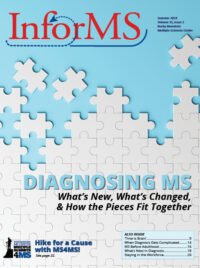Despite New Technology and Guidelines, Diagnosing MS isn’t Always Straightforward
The RMMSC’s Dr. Amanda Piquet specializes in MS and other autoimmune neurological disorders. We spoke to Dr. Piquet to get her perspective on diagnosing particularly complicated cases.
InforMS: When you see a patient for the first time, who either comes to you as a referral or comes to you without a diagnosis yet, where do you start and where do you go through to get to the final diagnosis?
Dr. Piquet: Often when patients come in and we are looking to make a diagnosis, I think it’s important to go through the clinical history first and understand all of the symptomology that the patient is experiencing. For me in particular, sometimes just the nature of my clinic given my area of expertise of other autoimmune diseases, I have patients that don’t fit nicely into the box of Multiple Sclerosis. Sometimes we need to explore other etiologies like rheumatologic disease and other autoimmune diseases that affect the central and peripheral nervous system. That’s where I rely a little bit more heavily on understanding patients’ personal and family history of other autoimmune diseases, not just asking about MS, but asking about autoimmune thyroid disease, lupus, rheumatoid arthritis for example. I also focus on additional symptoms that could be related to systemic rheumatologic disease, rather than isolated neurological symptoms, that could perhaps provide a clue.
InforMS: How common is it for you to see someone who has been referred to you for MS from either their primary care physician or another neurologist and then you have a total about-face and it’s not MS, it’s something completely different?
Dr. Piquet: I would say I don’t have a specific percentage off the top of my head, but I would say it’s more common than one would expect.
InforMS: Is it possible for you to go through and check things off right down the list of the McDonald criteria, and then still end up with a diagnosis that is not MS?
Dr. Piquet: Yes, and that happens frequently. The McDonald criteria can be helpful in the diagnosis of MS, but it’s not exclusive to MS. Therefore, you can meet all those check boxes and yet have a completely different disease. Patients come in and think they have MS based on a set of symptoms, but you can see that with other autoimmune neurologic diseases and sometimes it’s just a matter of doing the appropriate antibody testing.
For instance, Neuromyeltis Optica (NMO) is a distinct disease that is different from MS, but there can be presentations such as optic neuritis that can appear very similar to MS . Another example, is myelin oligodendrocyte glycoprotein (MOG) antibody-associated disease in which you can see presentations that are almost identical to MS. This is a relatively new antibody that has been commercially available for testing in the last two years so we are continuing to learn more about the disease, particularly surrounding treatment. Without doing the appropriate testing, we might not get to the diagnosis right away, which has important treatment implications because therapies are different from MS.
InforMS: Do you ever see someone who has two autoimmune diseases, maybe MS and something else active on top of it?
Dr. Piquet: Yes. Unfortunately, once you have one autoimmune disease, you are at risk for developing other autoimmune diseases. It’s very common to see the coexistence of autoimmune diseases. MS is seen less frequently with overlapping with other autoimmune diseases, but I certainly have patients with coexisting disease such as MS and Lupus, MS and Autoimmune Encephalitis… it’s rare, but it happens. It’s more common to see coexisting rheumatologic disease with neuromyelitis spectrum disorder such as lupus in addition to NMO, which has been well described.
InforMS: When you get someone who is a complicated case, are they coming to you first looking for clarification of an MS diagnosis, and then we figure out there are more complicated things going on? Or are these people at the end of a circuitous route through the medical system and finally ending up here to hopefully get a final diagnosis?
Dr. Piquet: I think there can be a combination of both; I would say the majority of patients that I consult on have already seen a general neurologist. So sometimes that can make things either more or less complicated, meaning at least some of the workup was already done by the time they see me. So, I have MRI data and sometimes spinal fluid data. But, it can also make it more complicated because of misdiagnosis if the work up has been incomplete or if there is a misinterpretation of the results.
Sometimes patients received the diagnosis of MS or another autoimmune disease, and then they come in and we are trying to backtrack and get back to the beginning to understand the clinical history. Based on the clinical history we have to ask, does that make sense with the testing results that we have in front of us?
It can become more complicated when we are changing diagnoses, as this can be quite confusing and scary for patients. It is critical that the diagnostic tests we order (blood work, MRI, CSF studies) are interpreted appropriate in the correct clinical context since often we have no one perfect test. We certainly can see it with MS; often when we review the brain MRI with patients in the appropriate clinical context. There are certain characteristics we look at, and not every white spot (on an MRI) is created equal. It’s not uncommon that we are saying, ‘no these spots don’t look like MS.’ This also happens with autoimmune neurologic disease where we get a lot of false positive antibody testing, or a positive antibody that doesn’t make sense based on the patients’ clinical syndrome, and so we are trying to backtrack and put that puzzle together.






